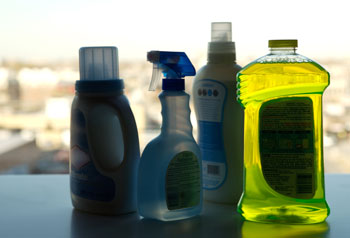Controlling Asthma Triggers at Home and Work
An important part of managing asthma is controlling triggers. These are things that make symptoms worse or that cause flare-ups. Triggers may be anywhere, inside or out. You can't completely get rid of triggers. But there are some things you can do to control them.

At home
Here are some things you can do at home:
-
Don’t let anyone smoke. Even if they smoke outside, it may still work its way inside. The smoke that they bring in on their clothes (third-hand smoke) can also cause asthma symptoms. If you smoke, ask your doctor for help quitting.
-
Keep windows closed to keep humid air outside. Use fans that vent outside in the kitchen and bathroom.
-
Don’t use fireplaces or wood stoves. Make sure that all appliances are correctly vented to the outside.
-
Don’t use strong-smelling products. This includes cleaning products, air fresheners, potpourri, candles, and incense.
-
Keep your home as clean as you can. Try to get rid of all clutter that could collect dust.
-
If you have pets, keep them off your bed and out of your bedroom.
-
Use air cleaners and vacuums designed to remove allergens. Change filters often. This includes furnace filters too. Vacuum and dust at least once a week.
At work
Here are some things you can do at work:
-
If your workplace is smoke-free, stay away from any smoking areas. If it is not smoke-free, think about talking to your manager.
-
If you notice that your symptoms get worse at work, talk with your doctor. Tell them what seems to make your symptoms better or worse. Together you can figure out the trigger.
-
Fumes, dust, or chemicals may be triggers. If you know the cause, it's possible it can be removed. For example, some cleaning products may set off your asthma. Your company may be able to use different ones.
-
You may be able to change your work situation to reduce your exposure to triggers. Choices include working at another location or from home, or working different hours (when there are fewer fumes, for example).
-
The Americans with Disabilities Act (ADA) may also help you and your employer. Go to the ADA website. Or call the ADA Information Line at 800-514-0301 (Voice) or 800-514-0383 (TTY).
-
See if poor airflow or ventilation may be a problem. Go to the Occupational Safety and Health Administration (OSHA) . Or call 800-321-OSHA (800-321-6742).
Online Medical Reviewer:
Deborah Pedersen MD
Online Medical Reviewer:
Heather M Trevino BSN RNC
Online Medical Reviewer:
Raymond Turley Jr PA-C
Date Last Reviewed:
9/1/2025
© 2000-2025 The StayWell Company, LLC. All rights reserved. This information is not intended as a substitute for professional medical care. Always follow your healthcare professional's instructions.